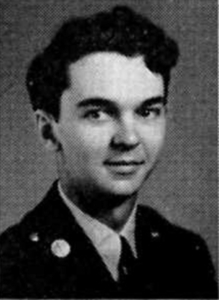Scroll of Honor – Edwin William Goddard
“One of Our Finest”
Written by: Kelly Durham
The war in Europe had been over for nearly a month, but the war in the Pacific appeared to be as vicious as ever. True, Japanese cities were taking a pounding from American bombers and the Navy was tightening its cordon around the home islands, but the Japanese military and government showed no signs of capitulation. As a result, the stateside training of new soldiers, sailors, and airmen continued at a relentless pace. One of the trainers was Edwin William Goddard.
Goddard arrived on campus in the late summer of 1941, a member of the last class to enroll at Clemson College before war came to the United States. An engineering major from St. Matthews, he was assigned to Company B, 1st Battalion, 1st Regiment of the Cadet Brigade. Rather than returning to campus for his sophomore year, Goddard enlisted in the Army Air Force and eventually qualified for flight training.
In Europe, General Eisenhower declared June 6, 1945, a training holiday for American forces to commemorate the first anniversary of the D-Day landings in Normandy. In the United States, it was just another Wednesday, with training operations continuing at bases all across the country. One of those bases was Spence Field, an Army Air Force training post about six miles southeast of Moultrie, Georgia. There, Second Lieutenant Goddard was serving as an instructor pilot assigned to the 2133rd Army Air Force Base Unit. Goddard’s job was to teach advanced single engine flying to Army aviation cadets.
 Goddard’s mission on that Wednesday was to instruct cadet Vincent Finewood in the AT-6 Texan, a single-engine advanced trainer aircraft widely used by both the Army Air Force and the Navy. Of course, given the pace of training, Goddard and Finewood weren’t the only crew in the air that day. Instructor pilot Second Lieutenant Frederick Schaeffer was also aloft in an AT-6 with his student, aviation cadet Jack Gibbs. In both cases, the instructors, Goddard and Schaeffer, were in the front seat of their aircraft, while the students were in the back seats. The AT-6 is a low-wing aircraft, limiting the pilots’ visibility below. At some point during the training flights, as both planes were about nine miles north of Berlin, Georgia, the two aircraft collided. All four occupants were killed and there were no witnesses to the accident. Army investigators determined that the likely cause of the crash was pilot error, that neither instructor saw the other plane as he was focusing his attention on his student.
Goddard’s mission on that Wednesday was to instruct cadet Vincent Finewood in the AT-6 Texan, a single-engine advanced trainer aircraft widely used by both the Army Air Force and the Navy. Of course, given the pace of training, Goddard and Finewood weren’t the only crew in the air that day. Instructor pilot Second Lieutenant Frederick Schaeffer was also aloft in an AT-6 with his student, aviation cadet Jack Gibbs. In both cases, the instructors, Goddard and Schaeffer, were in the front seat of their aircraft, while the students were in the back seats. The AT-6 is a low-wing aircraft, limiting the pilots’ visibility below. At some point during the training flights, as both planes were about nine miles north of Berlin, Georgia, the two aircraft collided. All four occupants were killed and there were no witnesses to the accident. Army investigators determined that the likely cause of the crash was pilot error, that neither instructor saw the other plane as he was focusing his attention on his student.
Edwin Goddard was remembered as a “young gentleman,” one of St. Matthews’ “finest young men.” Second Lieutenant Goddard was survived by his parents, one sister, and a brother, an Army major also stationed in Georgia. He was buried at West End Cemetery in St. Matthews.
For more information on Edwin William Goddard see:
For additional information on Clemson University’s Scroll of Honor visit:
https://soh.alumni.clemson.edu/
